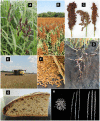Climate change challenges, plant science solutions
- PMID: 36222573
- PMCID: PMC9806663
- DOI: 10.1093/plcell/koac303
Climate change challenges, plant science solutions
Abstract
Climate change is a defining challenge of the 21st century, and this decade is a critical time for action to mitigate the worst effects on human populations and ecosystems. Plant science can play an important role in developing crops with enhanced resilience to harsh conditions (e.g. heat, drought, salt stress, flooding, disease outbreaks) and engineering efficient carbon-capturing and carbon-sequestering plants. Here, we present examples of research being conducted in these areas and discuss challenges and open questions as a call to action for the plant science community.
© The Author(s) 2022. Published by Oxford University Press on behalf of American Society of Plant Biologists.
Figures










References
-
- Agbona A, Teare B, Ruiz-Guzman H, Dobreva ID, Everett ME, Adams T, Montesinos-Lopez OA, Kulakow PA, Hays DB (2021) Prediction of root biomass in cassava based on ground penetrating radar phenomics. Remote Sens 13: 4908
-
- Aggarwal P, Vyas S, Thornton P, Campbell BM (2019) How much does climate change add to the challenge of feeding the planet this century? Environ Res Lett 14: 043001
-
- Ahmadi J, Pour-Aboughadareh A, Fabriki-Ourang S, Mehrabi AA, Siddique KH (2018) Screening wild progenitors of wheat for salinity stress at early stages of plant growth: insight into potential sources of variability for salinity adaptation in wheat. Crop Pasture Sci 69: 649–658
-
- Ainsworth EA, Long SP (2021) 30 years of free-air carbon dioxide enrichment (FACE): What have we learned about future crop productivity and its potential for adaptation? Global Change Biol 27: 27–49 - PubMed
-
- Albritton DL, Meira Filho LG, Cubasch U, Dai X, Ding Y, Griggs DJ, Hewitson B, Houghton JT, Isaksen I, Karl T. et al. (2001) Technical Summary. In Houghton JT, Ding Y, Griggs DJ, Noguer M, van der Linden PJ, Dai X, Maskell K, Johnson CA, eds, Climate Change 2001: The scientific basis. Contribution of working group I to the third assessment report of the intergovernmental panel on climate change, Cambridge University Press, Cambridge, United Kingdom and New York, NY, USA, pp. 881
Publication types
MeSH terms
Substances
Grants and funding
LinkOut - more resources
Full Text Sources
Medical
Miscellaneous

